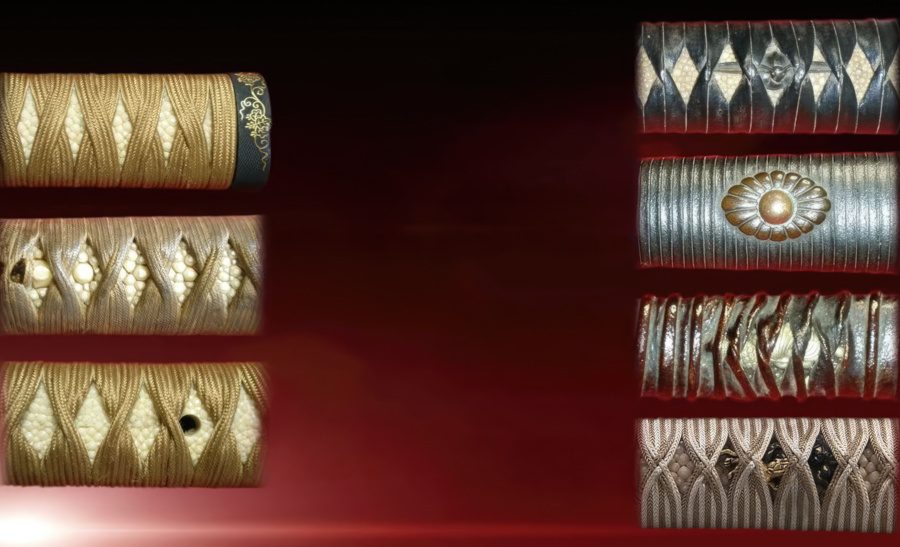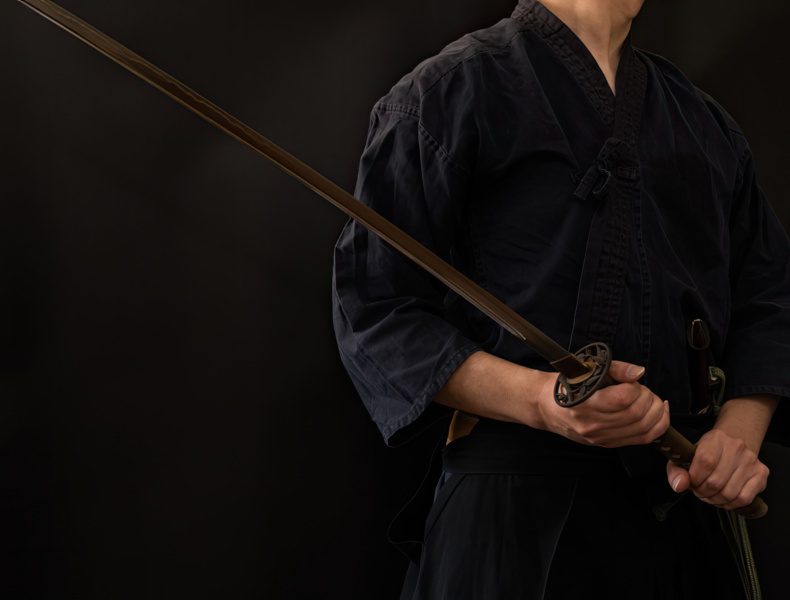What Are Katana Handles Wrapped In?

What’s in this article?
The tsuka, or handle of the katana, is one of the best hilts in the history of sword designs wrapped with layers of material. The layers are not for aesthetics alone, as they help make the katana one of the best-cutting swords in handling, precision, and edge alignment.
This article will go through the visible layers wrapped around the tsuka. We will start from the bottom layer and end with the top, explaining how these wraps assist in the overall functionality of the katana sword.
Samegawa

The tsuka handle’s core is made of two pieces of wood linked together but was previously constructed to go fully over the nakago full-tang blade underneath. On top of this wooden handle is the samegawa, the first layer wrapped around the katana handle.
This layer is traditionally made out of ray skin, called shark skin in Japanese, but some substandard katanas can be made out of leather, silk, and sometimes plastic. The samegawa has a white color with bubble-like patterns in different shapes called samehada.
Maru–gise is when the ray skin is fully wrapped around the handle, while tanzaku is partially wrapped and placed only in the center of the handle. The maedare–gise uses the most amount of samegawa with a wrap and a half to provide a better overall grip. The samegawa on a katana is only visible through the second layer called tsuka–ito.
Tsuka-Ito

The wrap on top of the samegawa ray skin is called a tsuka–ito or often just ito. This cord wrapping goes entirely around the tsuka katana handle and is traditionally made of silk, cotton, or leather. Each material for the tsuka–ito brings different handling attributes to the sword.
The tsuka-ito holds all the other fittings of the handle together underneath it. It traditionally comes in a dark color, contrasting the white samegawa beneath it. Diamond holes on the tsuka-ito allow the smaller mekugi pins under the menuki ornaments to be seen and pressed with a hammer to dismantle the entire handle easily.
The tsuka-ito isn’t glued to the handle. Instead, it is tightly tied up in a pattern called tsuka–maki that extends from under the tsuba guard to the bottom of the kashira pommel.
Tsuka-Maki

The art of tying up the tsuka-ito around the handle is called tsuka-maki, traditionally done to enrich the katana with aesthetics. It also adds a functional and overall rough pattern so the user’s hands will have a stable hold.
The tsuka-maki pattern can differ greatly because of how the cord is tied together. Some of the most popular tsuka-maki include:
- kata-hineri-maki
- shino-maki
- katate-maki
- gangi-maki
- kawa-tsumami-maki
- kata-tsumami-maki
- naka-biku-maki
- moro-tsumami-maki
- fuji-maki
- jabare-kaki-maki
The different types of maki are made to fit the different materials better and offer a better overall aesthetic, which is sometimes personally ordered when creating a Katana sword. Some tsuka-maki can be ordered with hishigami, triangle wedges added beneath the wrapping pattern, giving it better handling.
What Do the Katana Wraps Help With?

The different layers of wraps, such as the samegawa and tsuka–ito made into different tsuka–maki styles, are excellent for aesthetic and practical purposes, making the katana a unique blade. Here are some of the most well-known:
- Better Grip and Handling – both of the layers’ wraps help out significantly in giving the user a solid grip that results in better edge alignment and speed during cutting or iaido practices
- Rough Pattern – the samegawa and tsuka–maki styles give the handle a rough pattern which helps for a stronger and sturdier grip
- Protection – the wraps help protect the wooden core on top of the full-tang blade and the tsuka-ito. The hishigami protects the quality ray skin wrap beneath
- Non–Slippery – the different wrap materials help absorb any sweat on the user’s hands.
- Squeeze – the katana user can better squeeze the layers of wraps, especially with a hishigami, allowing for a superior grip on the sword when swinging it
- Personal Touch – different ray skin patterns, as well as different tsuka–kaki styles, can result in a personally crafted katana
- Traditional Design – traditionally, the two layers have been used by real samurai in history, and finding these genuine materials is difficult. Applying them to a katana handle makes the weapon a true work of art
For the katana wraps to be effective and bring their positives to the sword, they must be wrapped and mounted perfectly. Speaking to a professional before wrapping and unwrapping a katana is advisable if one does not have the proper experience.




